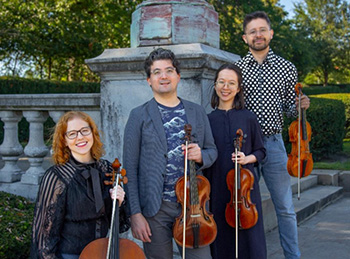by Daniel Hathaway
A string quartet from the chamber ensemble Wit’s Folly (Phaik Tzhi Chua & Guillero Salas-Suárez, violin, Jonathan Goya, viola & Jane Leggiero, cello) plays works by Joseph Eybler & Joseph Haydn today at noon at the Church of the Covenant (live stream available).
Visit our Concert Listings for details of these and other performances.
INTERESTING READS:
In The Guardian, Kenan Malik weighs in on one of the several issues raised by the 100th anniversary of George Gershwin’s Rhapsody in Blue. Read “A century on from Rhapsody in Blue, debates about cultural ‘theft’ rage still” here.
For the recent Leonard Bernstein biopic Maestro, actor Bradley Cooper insisted on filming the Mahler “Resurrection Symphony” scene in Ely Cathedral live — he’d been studying conducting for six years just to prepare for that. “On-set sound mixer Steven Morrow recalls it as a terrifying proposition — miking 200 chorus and orchestra members performing live in an echoey cathedral. So, he huddled with re-recording mixer Tom Ozanich, with whom he’d also worked on Cooper’s “A Star Is Born.” On that film they recorded all the singing live, but this was different.” Read the Los Angeles Times story here.
And The New York Times reports that Britain’s National Theater is considering start times as early as 6:30, breaking the sacrosanct tradition of 8 o’clock curtains. Other arts organizations are thinking about that too as they seek to lure audiences back after the pandemic and adjust to today’s audience preferences. “Theater start times have long been linked to meal times, according to Michael Burden, a professor at University of Oxford who has researched the connection. In 17th-century London, he said, everyone ate the day’s main meal at about 2 p.m. and would go to the theater afterward, with shows starting at about 4.” Read the article here.
TODAY’S ALMANAC:
Austrian pianist and composer Carl Czerny who was born on February 20, 1791, became one of Beethoven’s star pupils and was said to be able to play any of his master’s works from memory if merely requested by opus number.
Czerny is remembered today chiefly for his piano etudes, but his more than 1,000 compositions include such interesting works as the Piano Concerto in C for Four Hands, Op. 153, performed by Anna & Ines Walachowski with the Philharmonisches Orchester Altenburg-Gera led by David Porcelijn, and the Grand Piano Concerto No. 2 in E-flat featuring pianist Rosemary Tuck, principal horn : Hugh Seenan and the English Chamber Orchestra conducted by Richard Bonynge
Australian composer and pianist Percy Grainger le Symphony No. 5 in E-flat left the scene on February 20, 1961 in White Plains, NY, at the age of 78. Grainger joined a group of musicians in a lifelong quest to rescue British and Scandinavian music from central European influences, largely through the use of folk music, though he also dabbled in mechanical music-making (including recording piano rolls of his compositions and arrangements.)
Among Grainger’s most popular arrangements are wind band versions of Lincolnshire Posy (listen here to the Cleveland State University Symphonic Wind Ensemble’s performance at a Trinity Cathedral Brownbag Concert) and Irish Tune from County Derry (aka “Danny Boy,” performed here by the University of Michigan Symphonic Band). As a high schooler, I looked forward to hearing Irish Tune at the end of each of the University of Kansas summer music camp concerts, and still get the chills in the last verse when the horns suddenly soar out their counter melody.
And on February 20, 1996, Japanese composer Tōru Takemitsu died in Tokyo. His nature-based compositions are popular and frequently performed — especially by the New Music Ensemble at the Cleveland Institute of Music. Click on the links to listen to Water-ways, Rain Spell, and Toward the Sea.




